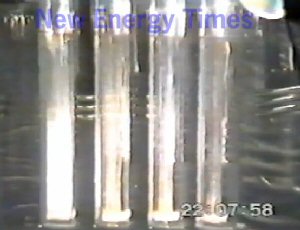Could LENRs Solve California Drought?

Boiling LENR Cells
April 2, 2015 – By Steven B. Krivit –
Could low-energy nuclear reactions (LENRs) be a solution to the California drought?
For the first time, Californians will face mandatory water restrictions as a result of historically low levels of water. Both groundwater and snowpack levels are severely depleted.
LENRs are a new field of science that, if developed into commercially viable technology, could power desalination plants to purify ocean water more cost-effectively.
LENR scientists have struggled for 26 years to understand this elusive scientific discovery. It was disputed when it was first announced by its discoverers, Martin Fleischmann and Stanley Pons, particularly because they said that it was a “cold fusion” reaction. It’s not, but the science behind the new phenomena is solid.
The research shows a variety of phenomena, of which some are highly reproducible. The heating effect has been the most challenging effect to reproduce. Nevertheless, several scientists have reported spectacular instances of boiling water with very little energy input.
In 1992, Fleischmann and Pons had learned enough about the science so that they could trigger LENR experiments to boil water on demand. The excess-heat phenomenon has been repeated many times; however, no other researchers have gained the control that the two pioneers had. On April 11, 1992, Fleischmann and Pons set up four cells that boiled dry and, in doing so, produced 144 Watts of excess heat. [1,2]
LENR research is undoubtedly challenging science. No viable LENR technologies are on the market today, despite the claims of a few hucksters and their followers. But with hard work, scientists may someday unlock these secrets of nature.
1. Published Journal Paper
2. Related Papers
3. Related Book
Questions? Comments? Submit a Letter to the Editor.

